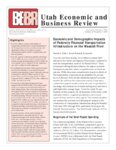TO
Filters: Collection: "ir_eua"
| Title | Date | Subject | Description | ||
|---|---|---|---|---|---|
| 201 |
 |
Chapter 6 | |||
| 202 |
 |
Economic and demographic impacts of federally financed transportation infrastructure on the Wasatch Front | 2004-09 | Over the next three decades, $14.4 billion (constant 2004 dollars) of new transit and highway infrastructure is planned to meet the transportation needs of the Wasatch Front.1 These investments will significantly influence the region's economic development potential, relative competitiveness, and la... | |
| 203 |
 |
Officers of Instruction and Administration | |||
| 204 |
 |
Officers of Instruction and Administration | |||
| 205 |
 |
Officers of Instruction and Administration | |||
| 206 |
 |
Part 999 | |||
| 207 |
 |
Clean and secure energy from domestic oil shale and oil sands resources: Quarterly progress report: January 1, 2010 to March 31, 2010 | 2010-05-13 | ICSE; University of Utah; CO2 capture; Mahogany zone; Green River Formation; Utah; Uinta Basin; Oil sands; Crude oil refining; International Flame Research Foundation; Liquid fuel production; In-situ thermal treatment; Oil shale; Pyrolysis | The Clean and Secure Energy from Domestic Oil Shale and Oil Sands Resources program is part of the research agenda of the Institute for Clean and Secure Energy (ICSE) at the University of Utah. In this quarter, the Clean and Secure Energy program continued its focus on enhancing industrial, national... |
| 208 |
 |
Field guide to lacustrine and related nonmarine depositional environments in tertiary rocks, Uinta Basin, Utah | 1976-11 | lacustrine environments; nonmarine depositional environments; tertiary rocks | The lower part of the Tertiary System in the Uinta Basin of northeastern Utah and northwestern Colorado (fig. 1) reflects a series of very complex and variable forms of continental sedimentation in a basin of internal drainage. These complex forms represent the disruption of the Cretaceous depositio... |
| 209 |
 |
The synthetic liquid fuel potential of Utah | 1951-10-15 | synthetic liquid fuel potential; oil-impregnated stripable deposits; oil saturation | Oil-impregnated stripable deposits are known in Carbon, Grand, and Uinta Counties in the Uinta Basin, in the northeastern part of the State (Exhibit No. D-l). Many of the deposits are narrow veins too small to be important, but larger deposits of bituminous sand and oil-saturated sandstones are foun... |
| 210 |
 |
Light-oils transformation to heavy oils and asphalts-assessment of the amounts of hydrocarbons removed and the hydrological-geological control of the process | 1987 | light-oils; heavy oils; asphalts; assessment; hydrocarbons; petroleum resources; oil alteration | Heavy oils frequently represent a residue left after removal of saturated and aromatic hydrocarbons by various alteration processes. They are characterized by a high content of asphaltenes and polar compounds and by higher sulfur content than the light oils from which they were derived. In the Dead ... |
| 211 |
 |
Student Services | |||
| 212 |
 |
Baseline scenario 1998 | 1998-02 | ||
| 213 |
 |
Bituminous sandstone deposits Asphalt Ridge | 1966-12 | Asphalt Ridge probably is the second largest bituminous sandstone deposit in northeastern Utah's Uinta Basin. Discontinuous concentrations of bitumen occur in the Rim Rock Sandstone of the Mesaverde Group of Cretaceous age, in the overlying Uinta Formation of Eocene age and the Duchesne River Format... | |
| 214 |
 |
Control of geological carbon sequestration in the western United States | 2011-05 | coal; carbon dioxide; electric utilities; carbon sequestration; sequestration; geological sequestration; climate change | In the near future, the use of coal may be legally restricted due to concerns over the effects of its combustion on atmospheric carbon dioxide concentrations. Carbon capture and geologic sequestration offer one method to reduce carbon emissions from coal and other hydrocarbon fuel. While the federal... |
| 215 |
 |
Urban planning tools for quality growth | 2000 | Formed in January of 1997, Envision Utah is a public/private community partnership dedicated to studying the effects of long-term growth in the Greater Wasatch Area of northern Utah. Sponsored by the Coalition for Utah's Future, Envision Utah and its partners - with extensive input from the public -... | |
| 216 |
 |
UUSAC UHESA 1993-1994 | 1994 | Bylaws; Univerity of Utah staff; Minutes | Utah Higher Education Staff Association directory, meeting minutes, constitution and bylaws for 1993-1994. |
| 217 |
 |
1959-60 General Catalog; University of Utah catalogue; (Catalog) | 1959 | University of Utah catalogue; (Catalog) | Bulletin of the University of Utah, Volume 50, May, 1959, Number 4. General Catalog 1959-1960. |
| 218 |
 |
Classification, petrographic expression, and reflectance of native bitumen | 1998-11-19 | Native bitumen is naturally occurring, solid organic material that originates, with few exceptions, from material expelled by sedimentary organic matter during catagenesis. Note that, in this text, the word bitumen is used to mean "native bitumen" rather than the common meaning of organic matter ext... | |
| 219 |
 |
Digitized log file, API Number 4304733794 | 2009 | This log was digitized by the Utah Geological Survey from image files (.tiff) compiled by the Utah Division of Oil, Gas, and Mining | |
| 220 |
 |
UUSAC SWAB 1997-1998 | 1998 | Staff salaries; University of Utah benefits | Letters, memos, agendas and membership information for the Salaries, Wages and Benefits Subcommittee. |
| 221 |
 |
UUSAC UHESA 1997-1998 | 1998 | Bylaws; Policies | Memos, bylaws, and policies of the Utah Higher Education Staff Association (UHESA) |
| 222 |
 |
Chapter 19 | |||
| 223 |
 |
Digitized log file, API Number 4304731065 | 2009 | This log was digitized by the Utah Geological Survey from image files (.tiff) compiled by the Utah Division of Oil, Gas, and Mining | |
| 224 |
 |
Monitoring surfactant content to control hot water process for tar sand | 1991-04-23 | Patent; Hot water process; Tar sand; Extraction; Surfactants | The present invention is based on the following: (1) that when tar sand is conditioned and diluted in the hot water extraction process, there are two classes of anionic surfactants (originating from carboxylate and sulfonate groups) present in the process water; (2) that each of these surfactants ha... |
| 225 |
 |
Process to separate bituminous material from sand (tar sands) | 1982-08-03 | Bituminous sand; oil sand; tar sand; separate bituminous material from sand; bitumen separation | Bituminous sand such as oil sand or tar sand is mixed with a halogenated organic solvent which has a density greater than that of water at the same temperature. The slurry is continuously transferred to a conveyor system which is at least partially submerged in water, with the slurry being fed onto ... |
